Silicates: Datolite
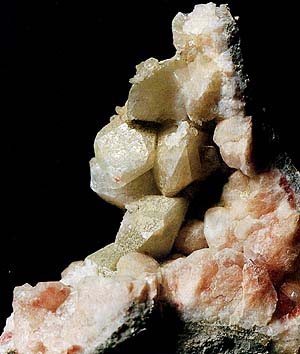 Diagnostic card.
Diagnostic card.
On the picture. Large crystals of datolite, painted in colors from white to light red.
Ca B OH SiO 4
Singonia monoclinic
Hardness 5-5,5
Specific weight 2,9-3
Cleavage is absent
Fracture irregular, conchoidal, brittle
Color is colorless, white, yellow, green, red
Color in powder white
Glitter is glassy, greasy

It is represented by short crystals, sometimes of large size, rich in facets. Quite often, however, porcelain aggregates of fine-grained and massive addition. Coloring can either be absent, or change from white to yellowish, greenish and even light red. The gloss of datolite is glassy with a tendency to bold; Fracture is conchoidal.
Chemical composition. Calcium oxide (CaO) 35%, boron oxide (B2O3) 21.8%, silica (SiO2) 37.6%, water (H2O) 5.6%. Shingonia. Monoclinic: crystals are characterized by an abundance of faces. Class of symmetry. Prismatic - 2 / m. Aggregates. Granular. Cleavage. Absent.
Diagnostic signs.
Melts in the flame of a candle, coloring it in green. Easily soluble in strong acids. Easily alloyed in clear glass. Behavior in acids. It decomposes in HCl.
Origin.
Mineral of hydrothermal origin; Often found in voids among serpentinites and rocks poor in silica, such as basalts, melaphyres and diabases. It is also noted in some rocks of the granite series.
Deposits and applications.
Datolite is a very common mineral. In Italy, it occurs in the tonsils of the chalcedony in Tizza near Chuse, in the Alto-Adige region, in the pink granite sticks in Baveno near Lake Lago-Major, in the Piedmont region. This mineral is often found also in Serra-Zacchetti (province of Bologna), in Montecatini in Val di Cecina and in Casarza (Liguria region). It is found in the Tyrol and the US, where its opaque differences are used as an ornamental stone, limiting it in the form of a convex cabochon. If datolite forms large deposits, it is developed as a raw material for the production of boron and paints used in the manufacture of porcelain.
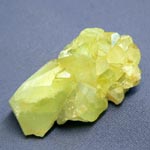
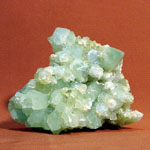

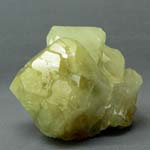
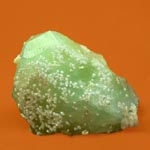
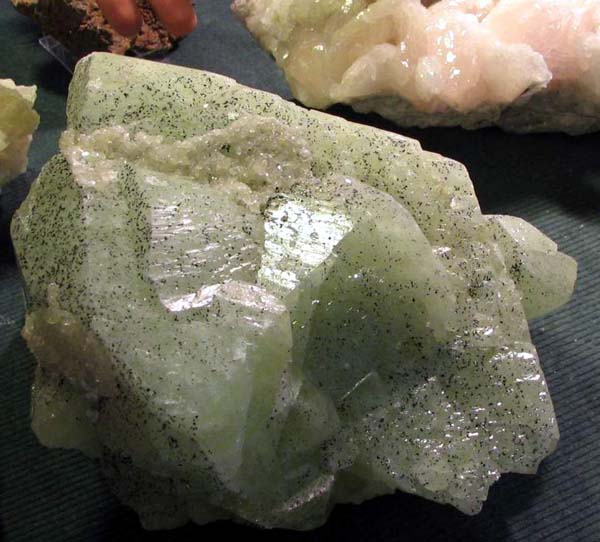
Datholith. Borosilicate deposit, Dalnegorsk, Primorye, Russia. Crystal ~ 20 cm. Photo: © А.А. Evseev.
Boron refers to immunotoxic elements. It is believed that the upper limit of the average daily, safe dose of boron consumption for humans is 13 mg. Boron is a synergist of chlorine, enhances the action of concentrated alcohol and some antibiotics. With a deficit of boron, the risk of vitamin D deficiency increases. Boron inhibits the absorption of ascorbic acid, flavonoids, sulfur-containing amino acids by the body. The use of boron to expel copper from the body is described. It is an element in the prevention and treatment of osteoporosis.
With an excess of boron in the body there are: loss of appetite, nausea, vomiting, watery stool, dehydration, skin rashes and flaking, decreased sexual activity, deterioration of spermogram. Over-saturation with boron leads to hair loss, polymorphic dry erythema and anemia, which occur during normalization of boron level. Boron oxide and orthoboric acid are classified as potent toxic substances. The presence on air contaminated with boron compounds causes irritation of the nasopharynx and the eyes. Studies show that when breathing in air with contamination with boron compounds, lung damage develops.
When ingesting boron in higher concentrations, irritation of the gastrointestinal tract occurs. With prolonged exposure to boron compounds, the digestive process becomes chronic ("boron enteritis" develops), and boron intoxication that can affect the liver, kidneys, central nervous system. In studies, the negative impact of boron on reproductive function in both males (decreased sperm production and development of testicular atrophy) and in women during pregnancy (toxic effect on the embryo - with the appearance of defects in newborns) was revealed.
Boron can enter the body with skin contact with cosmetics containing boron compounds (hysteria beginning of the XXI century), and with detergents (their wide advertising). In food, boron is contained in the form of sodium tetraborate decahydrate and boric acid (this is not "potassium permanganate", not potassium permanganate). Boron compounds are excreted in the urine. Boron plays an essential role in the metabolism of carbohydrates and fats, a number of vitamins and hormones, affects the activity of enzymes.
In humans, boron is required in microdoses to maintain healthy bones, metabolic processes of calcium, phosphorus and magnesium. Bor helps to prevent postmenopausal osteoporosis, strengthens muscles, improves brain function, increases vitality. Boron is needed: boron promotes the prevention of postmenopausal osteoporosis and the growth of muscle tissue.
- Ghetchellit - "New Almaden blend" - arsenide and antimony sulfide (modern sulfosol)
- Antimony is a toxic metal (semimetal) , widely used in metallurgy, medicine and engineering
- Zirconium - a rare and undiscovered metal and the most dangerous precious stone in oxide and salt
- Gold - yellow dangerous and poisonous metal of modern accurate digital and cable technologies
- Sulfur is a golden-yellow toxic substance and a sign of active volcanic activity
- Cadmium is an undisputed toxic silvery metal unknown to a wide range of people
- Lead - a toxic gray imitator of metallic silver and toxic metal blende
- Arsenic is a classic poison of medieval and modern poisoners and medicine in medicine
Poisonous and radioactive dangerous stones and minerals
** - poisonous stones and minerals (mandatory check in the chemical laboratory + explicit indication of toxicity)
** - radioactive stones and minerals (mandatory check on the standard dosimeter + ban on open sales in case of radioactivity exceeding 24 milli / g / h + additional measures of population protection)
Catalog of minerals and semi-precious stones of the world by groups
** - poisonous stones and minerals
** - radioactive stones and minerals


Comments
When commenting on, remember that the content and tone of your message can hurt the feelings of real people, show respect and tolerance to your interlocutors even if you do not share their opinion, your behavior in the conditions of freedom of expression and anonymity provided by the Internet, changes Not only virtual, but also the real world. All comments are hidden from the index, spam is controlled.